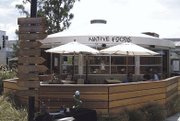Courting the Eco-Savvy Consumer
Environmental design has evolved from hippie to hip in the last two decades. And there may be no bigger advocate of the phenomenon than developer Shaheen Sadeghi, who gambled that environmentally friendly buildings would excite shoppers as much as a hot premium-denim label.
Four years ago, Sadeghi spent about $20 million to open one of the first environmentally sustainable shopping centers in the world, The Camp, in Costa Mesa, Calif. He was motivated by the notion that consumers would be guided by environmental concerns when they decided where to shop and which clothes to buy.
But the 52-year-old Sadeghi knew that people wouldn’t run to his shopping center with just a mere stamp of approval from an environmental group. The shopping center had to look hip. It also had to be fun. And it needed to capture an elusive ’wow’ factor.
That is where The Camp project got tricky.
Sadeghi competes for attention in Orange County, Calif., one of the toughest retail markets in the United States. The county’s premier luxury shopping center, South Coast Plaza, is less than one mile away. And his own successful experiment with a youth-oriented shopping center, The Lab, is located across the street from The Camp.
Sadeghi said that Orange County shoppers have not only seen almost every retail concept, but are highly sophisticated and quick to sniff out a fraud.
So the owner had to not only prove that he could juggle great retail— since he dared to make a statement about protecting the environment— but had to show that he was ready to back up his words with action.
The Camp has had no problems attracting compelling stores. The shopping center is 100 percent leased and sales per square foot are above average, ranging from $400 to $650, according to Sadeghi.
As for action, he assembled a team to make the place as fun as a hike in Yosemite. They also were entrusted to design and construct a place that would meet their objectives of energy efficiency and improving air and water quality.
Water quality was one of the first concerns at the shopping center, located just a few miles from the ocean. The Camp’s parking lot is sloped, which allows rainwater and water used to wash the building to collect in a system of subterranean tanks. Once inside the tanks, toxins are filtered from the water before it enters the underground water table and reaches the ocean.
Sadeghi worked with San Diego–based Spurlock Poirier Landscape Architects to create plant beds native to Southern California’s semi-arid environment.
The plants require little water and reflect the region’s natural environment.
Spurlock Poirier designed five different microhabitats for The Camp. One is devoted to desert plants such as cacti. Another, which represents California’s alpine area, is dominated by a shady grove of 100-foot pine trees.
The buildings, designed by Newport Beach, Calif.–based Bauer and Wiley Architects, were created to be beautiful and energy efficient, Sadeghi said.
The roof of the Adventure 16/Patagonia boutique is covered with six inches of grass and California wildflowers. The roof’s groundcover keeps the building’s interior temperature cool, said Chris Bennett, The Camp’s director of development.The center’s architects increased the building’s use of natural daylight, which minimizes the need for electricity. Jay Bauer, a partner with Bauer and Wiley, estimated that electricity costs decrease 10 to 20 percent with buildings designed with the environment in mind.
The center’s buildings are made with recycled woods, metals and various types of concrete.
Bauer said the market for environmental design and the availability of green materials has recently increased.
“The Camp was among the early adapters in sustainable design for all the right reasons,” he said. “There are designs that are more progressive now, but clients are more willing to embrace environmental design because of projects like The Camp.”
Sadeghi’s next project, the SoBeCa residential area adjacent to The Camp and approved by the Costa Mesa City Council in April, also will be guided by an environmentally sensitive design.
He believes designing this way is here to stay even if it takes time for people to get used to the building green concept.
“Environmentalism went from extreme to mainstream,” Sadeghi said. “It’s a cultural shift, and we are in front.”






















